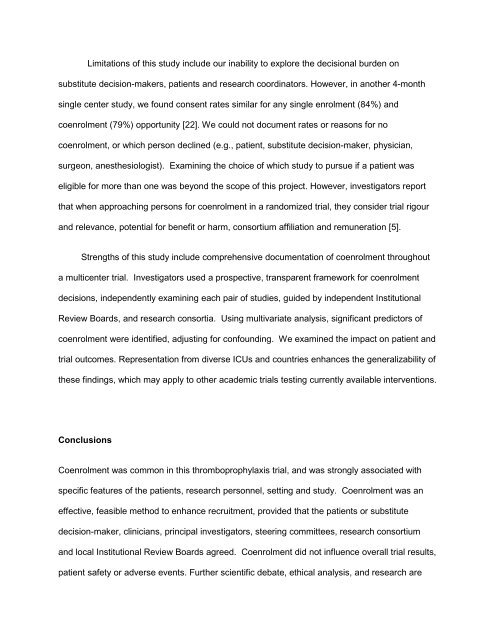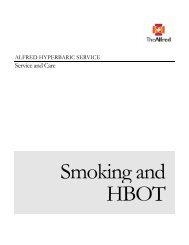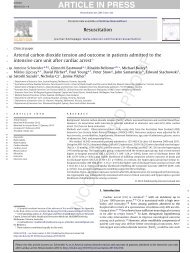Critical Care
See Full Article - Alfred Intensive Care Unit
See Full Article - Alfred Intensive Care Unit
- No tags were found...
Create successful ePaper yourself
Turn your PDF publications into a flip-book with our unique Google optimized e-Paper software.
Limitations of this study include our inability to explore the decisional burden on<br />
substitute decision-makers, patients and research coordinators. However, in another 4-month<br />
single center study, we found consent rates similar for any single enrolment (84%) and<br />
coenrolment (79%) opportunity [22]. We could not document rates or reasons for no<br />
coenrolment, or which person declined (e.g., patient, substitute decision-maker, physician,<br />
surgeon, anesthesiologist). Examining the choice of which study to pursue if a patient was<br />
eligible for more than one was beyond the scope of this project. However, investigators report<br />
that when approaching persons for coenrolment in a randomized trial, they consider trial rigour<br />
and relevance, potential for benefit or harm, consortium affiliation and remuneration [5].<br />
Strengths of this study include comprehensive documentation of coenrolment throughout<br />
a multicenter trial. Investigators used a prospective, transparent framework for coenrolment<br />
decisions, independently examining each pair of studies, guided by independent Institutional<br />
Review Boards, and research consortia. Using multivariate analysis, significant predictors of<br />
coenrolment were identified, adjusting for confounding. We examined the impact on patient and<br />
trial outcomes. Representation from diverse ICUs and countries enhances the generalizability of<br />
these findings, which may apply to other academic trials testing currently available interventions.<br />
Conclusions<br />
Coenrolment was common in this thromboprophylaxis trial, and was strongly associated with<br />
specific features of the patients, research personnel, setting and study. Coenrolment was an<br />
effective, feasible method to enhance recruitment, provided that the patients or substitute<br />
decision-maker, clinicians, principal investigators, steering committees, research consortium<br />
and local Institutional Review Boards agreed. Coenrolment did not influence overall trial results,<br />
patient safety or adverse events. Further scientific debate, ethical analysis, and research are









